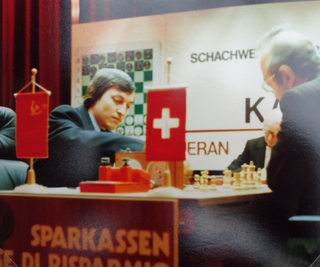The Latvian Gambit is a chess opening characterised by the moves:
The Ruy Lopez, also called the Spanish Opening or Spanish Game, is a chess opening characterised by the moves:
The Two Knights Defense is a chess opening that begins with the moves:
The Philidor Defence is a chess opening characterised by the moves:
The Vienna Game is an opening in chess that begins with the moves:
The Bishop's Opening is a chess opening that begins with the moves:
The Scotch Game, or Scotch Opening, is a chess opening that begins with the moves:
The Dunst Opening is a chess opening in which White opens with the move:
The Ponziani Opening is a chess opening that begins with the moves:

The World Chess Championship 1886 was the first official World Chess Championship match contested by Wilhelm Steinitz and Johannes Zukertort. The match took place in the United States from 11 January to 29 March, the first five games being played in New York City, the next four being played in St. Louis and the final eleven in New Orleans. The winner was the first player to achieve ten wins. Wilhelm Steinitz won the match 10–5, winning his tenth game in the twentieth game of the match. There were five draws.

The World Chess Championship 1889 was the second official World Chess Championship, and was between Wilhelm Steinitz and Mikhail Chigorin. It took place in Havana, Cuba. Steinitz defended his world title, and was the first of the two players to reach 10½. He won the match 10½-6½.
A Steinitz Variation is any of several chess openings introduced and practiced, or adopted and advocated by Wilhelm Steinitz, the first officially recognized World Chess Champion.

The third World Chess Championship was held in New York City from 9 December 1890 to 22 January 1891. Holder Wilhelm Steinitz narrowly defeated his Hungarian challenger, Isidor Gunsberg.

A World Chess Championship was played between challenger Max Euwe and title-holder Alexander Alekhine in various cities and towns in the Netherlands from 3 October to 16 December 1935. Euwe was the winner by overcoming a three-point deficit as late as the ninth game.

The 1978 World Chess Championship was played between Anatoly Karpov and Viktor Korchnoi in Baguio, Philippines, from July 18 to October 18, 1978. Karpov won, thereby retaining the title.

The 1981 World Chess Championship was played between Anatoly Karpov and Viktor Korchnoi in Merano, Italy from October 1 to November 19, 1981. Karpov won with six wins against two, with 10 draws. The two players had already played against each other in the World Chess Championship match 1978 in the Philippines, when Karpov also won.
The Berlin Defence is a chess opening that begins with the moves:





